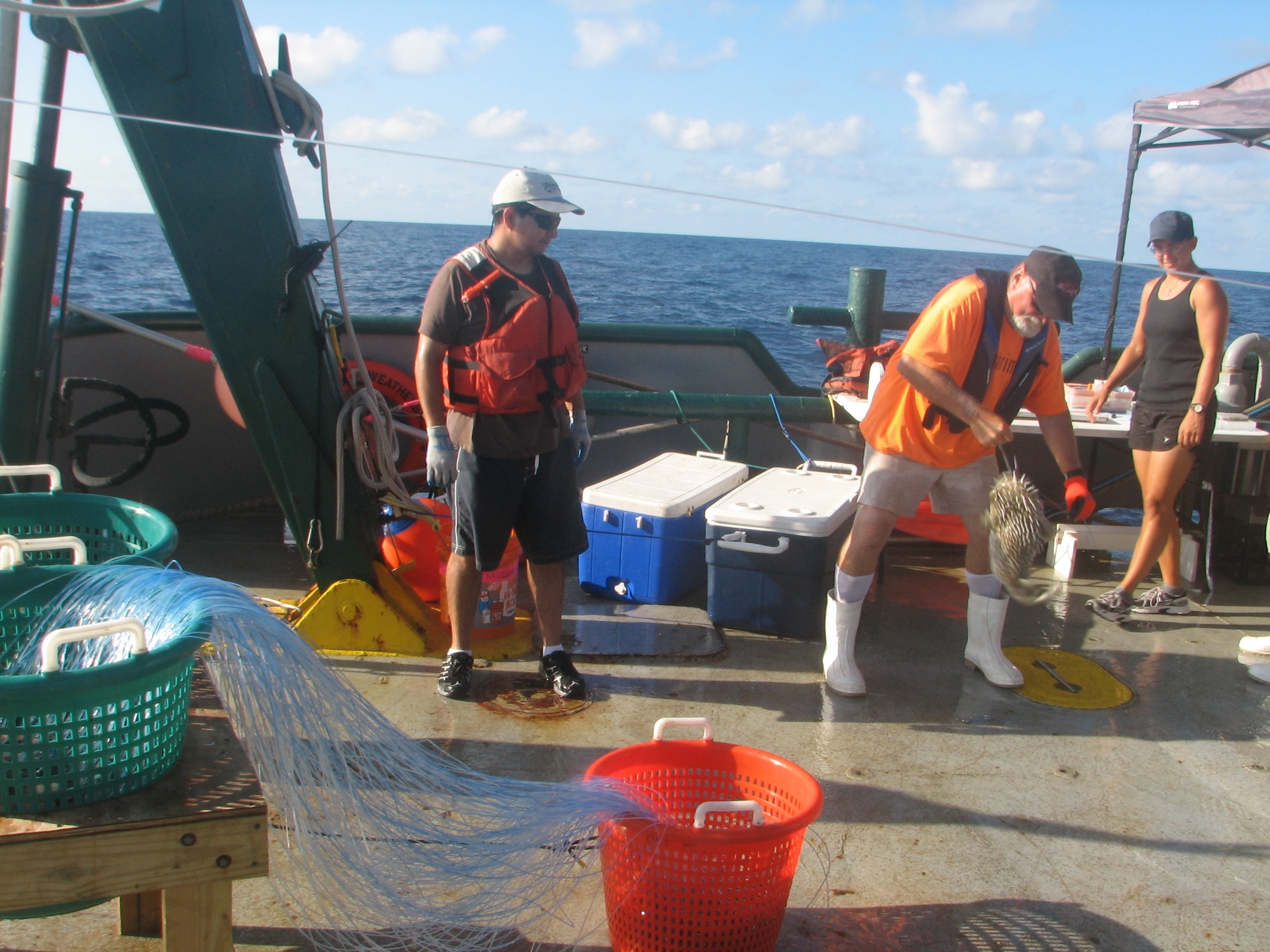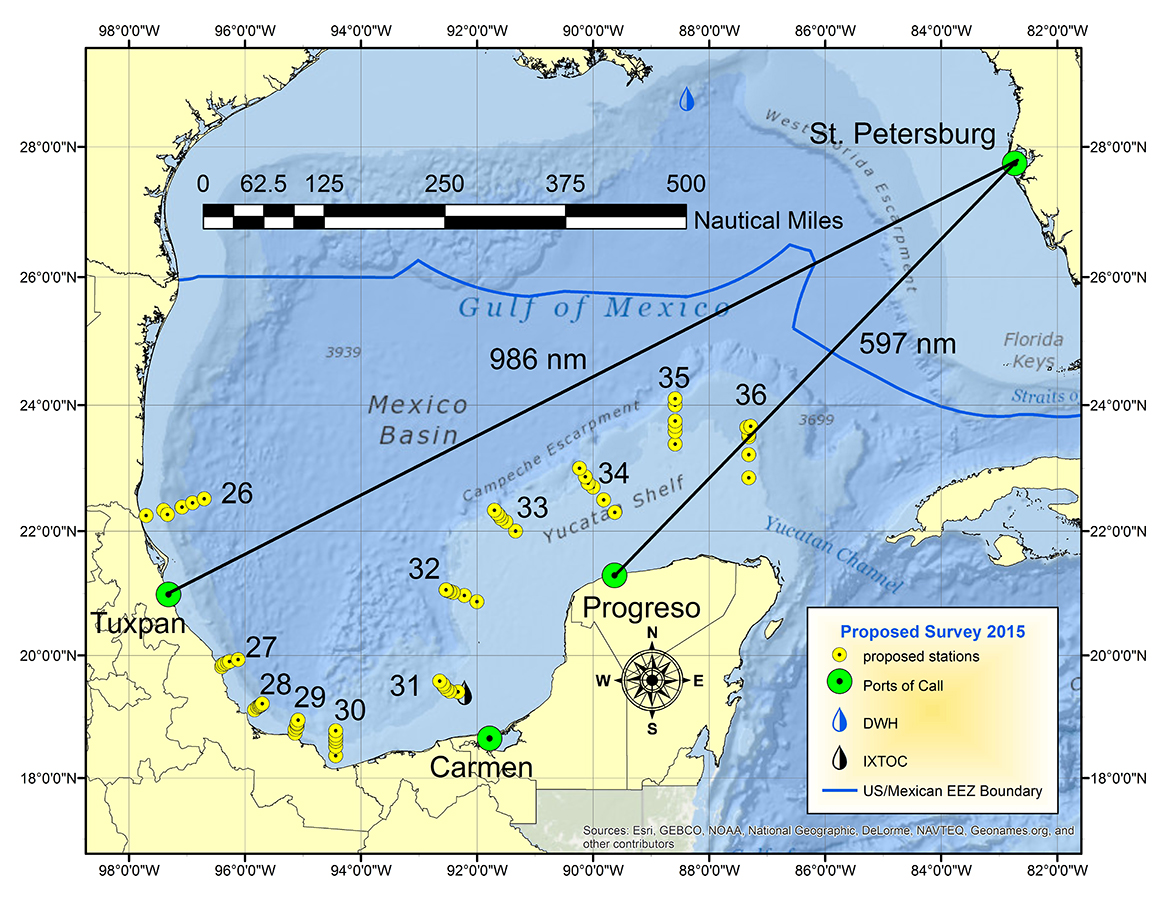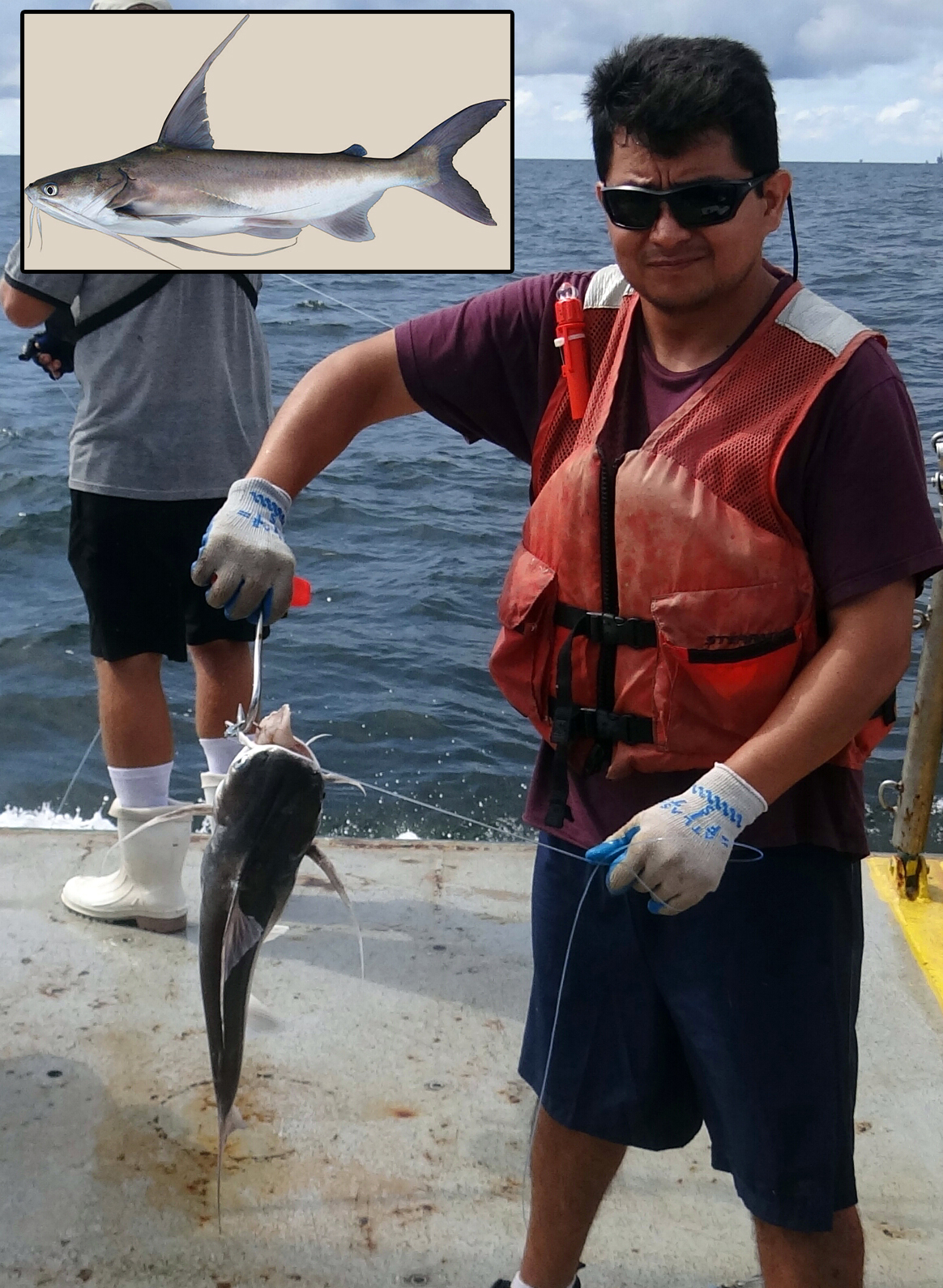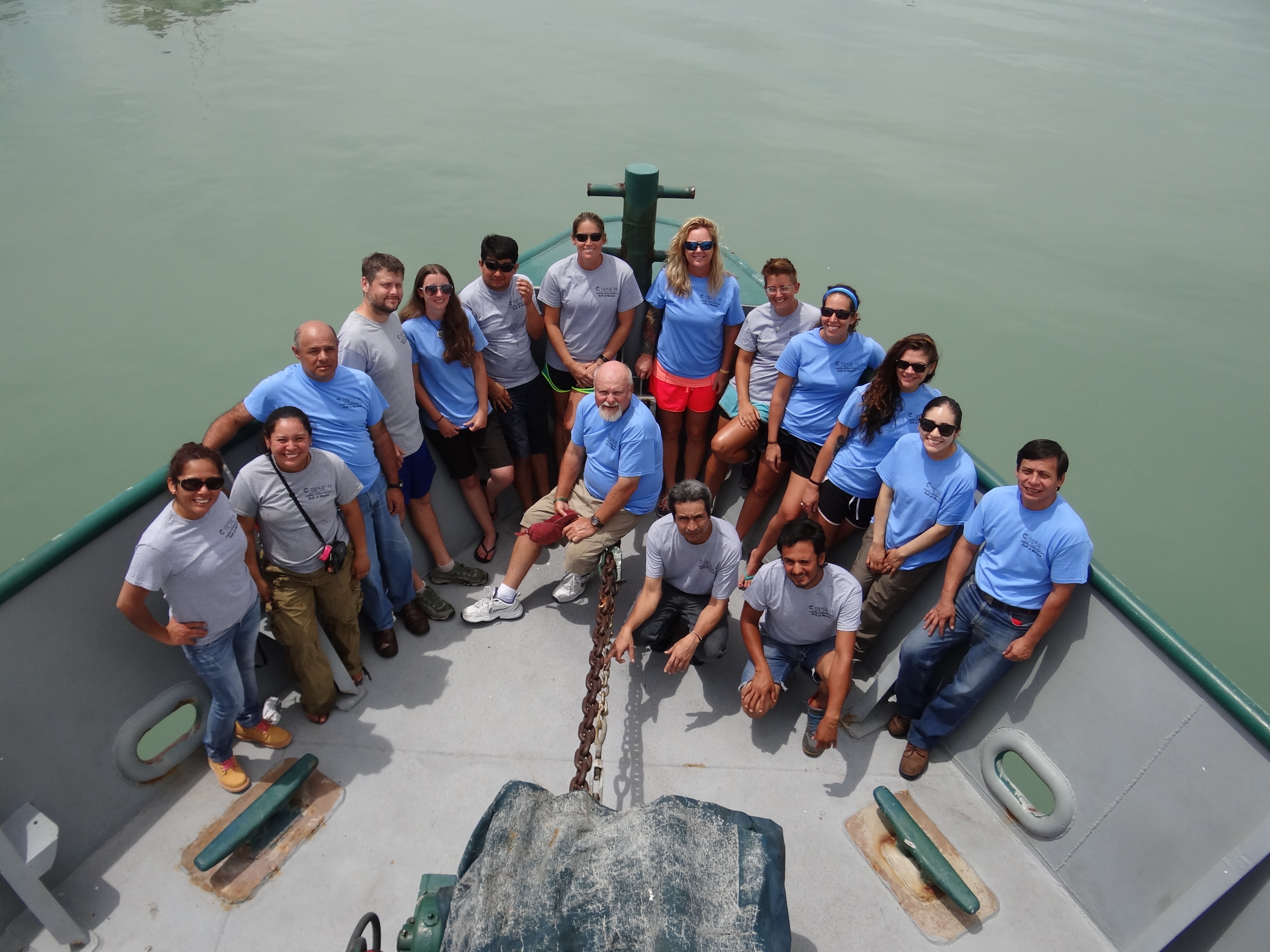
Southern GoM Longline Expedition
C-IMAGE researchers on the Weatherbird II get ready for setting the longline for fish collection
With thirteen scientists aboard, the R/V Weatherbird fired up its engines earlier this month at the USF College of Marine Science in St. Petersburg, FL, for its straight shot across the Gulf of Mexico into Mexican waters. Their science mission is to begin the first ever Gulf-wide fish health survey establishing much needed baseline information about some dominant Gulf fish like red snapper, golden tilefish, king snake eel and Atlantic sharpnose sharks.
Steven Murawski, Chief Scientist for the expedition and Director for the Center of the Integrated Modeling and Analysis of the Gulf Ecosystem (C-IMAGE) is leading a team of researchers on a 22-day sampling expedition through the southern Gulf of Mexico. C-IMAGE – a Gulf of Mexico Research Initiative (GoMRI)-funded consortium of 19 institutions from six countries – is committed to understanding the complex chemical and biological interactions related to marine oil blowouts of the Gulf of Mexico. Murawski’s team of technicians, graduate students and post-doctoral researchers began studying the impacts of oil exposure on fish just after the Deepwater Horizon (DwH) blowout.
Their attention now turns to the southern Gulf of Mexico. In 1979, the Ixtoc-I exploratory well suffered an oil blowout followed by 10 months and 3.5 million barrels of spilled oil into the southern Gulf of Mexico. Shortly after, PEMEX, the Mexican state-operated oil company, established an exclusion zone around the Ixtoc-I site. Only vessel traffic directly related to platform operations is allowed in the 4,000 km2 exclusion region, until now. Our researchers gained special access through the Mexican government to conduct scientific fishing within the exclusion zone.

After arriving and being processed at the intake Port of Progresso on September 17, 2015 the RV Weatherbird II made its way north, then gradually southwest along the Yucatan Shelf. The research team sampled from sunrise to past sunset, often averaging 14-hour days at transects 32, 33, and 34 in the northwest Yucatan (Figure 2).
Dr. Shannon O’Leary is a genomics researcher from Texas A&M University, Corpus Christi who is aboard the vessel for the three week trip. “We were all very curious to see what we would get on our first set [in the exclusion zone]. Theory is that if nobody has fished here for so long, we should have more fish, bigger fish and a greater diversity of fish. On the other hand, there is quite a bit of pollution from the well heads and the associated activities of building and maintaining the platforms.”
Time told the story, large numbers of fish, mostly Gafftopsail catfish (Figure 3) were caught there. These catfish have been studied for PAH exposure (a toxic derivative in oil) around the exclusion zone, so having samples within the Ixtoc-I vicinity offers an interesting historical perspective, especially since they are found on the bottom and in contact with possibly oiled sediments.

Research published last year from C-IMAGE found evidence of a marine snow event associated with the DwH spill creating a mechanism for oiled particles to reach the seafloor. Initial sediment work around the Ixtoc-I site from C-IMAGE collaborations with members of the Instituto de Ciencias del Mar y Limnología at Universidad National Autónoma de Mexico (UNAM) and USF indicate a similar event may have occurred in the southern Gulf. This finding may have cascading effects on burrowing fish and other benthic marine life.
Researchers are collecting fish muscle, bile, blood, liver, heart, otoliths, eyeballs and fin clip samples for genomic studies, stock health assessment, PAH compound concentrations, and any sublethal symptoms that may be related to long term low levels of hydrocarbon exposure through habitat or diet. They continue to survey the commercially relevant red snapper and other fish of interest like golden tilefish, and king snake eel.
After visiting the exclusion zone, researchers from UNAM, TAMU-CC, USF, and Florida State University continued to sample southwest then northwest along Veracruz. This region is the expected resting place for a majority of oil following the 1979 Ixtoc-I disaster. In these shallowest stations, researchers caught 15 tilefish and large numbers of Gulf hake. “The significance of this catch cannot be overemphasized”, Murawski said. “We now can compare tilefish in the Southeast Campeche region near the oil producing area with a similar catch from earlier in the expedition (perhaps non-polluted). This species is predominant and highly polluted in the northern Gulf. We can now answer the question, are tilefish equally heavily polluted by PAHs in the entire Gulf or just in the vicinity of the DwH?”
Figure 3 Dr. Joel Ortega-Ortiz unhooks a Gafftopsail catfish.
Dr. Adolfo Gracia is the UNAM science lead for C-IMAGE and a member of the Mexican Academy of Sciences. He has been studying shrimp fisheries in the southwest Gulf of Mexico and impacts of environmental contamination for over 30 years. “The fish cruise was extremely successful, we can hardly wait to see the findings and compare them with existing data of sediment oil and biological analyses recorded by UNAM and our C-IMAGE partners in the Ixtoc-I area. This will give important hints for understanding long term fish communities and ecosystem responses to oil megablowouts.” His team returns to Mexico City with hundreds of biological samples that will be analyzed over the next year.
The research team will exit Mexico at Tuxpan and begin their five day journey home along the longest axis of the Gulf, west to east. While underway, the science will continue. Researchers will measure basic oceanographic variables and collect water to gain information about the vertical and horizontal distributions of plankton, fish eggs and larval distributions across the Gulf. They will also take water samples to assess microplastic concentrations across the Gulf.
While on board, researchers populated blogs summarizing their experiences and photo-documented the trip. Please visit our website and check back often for updates.
http://www.marine.usf.edu/c-image/our-blog

The full science party (from left to right): Balbina Suárez Achával, Itzel Michel López Durán, Juan Antonio Frausto Castillo, David Portnoy, Brittany Verbeke, Joel Ortega-Ortiz, Amy Wallace, Erin Pulster, Shannon O’Leary, Susan Snyder, Kristina Deak, Lt. Paola Moreno, Gustavo Enciso Sánchez, Steven Murawski, Daniel Gasca Flores, José Martín Ramírez Gutiérrez
C-IMAGE scientists will return to the southern and western Gulf next year to continue the fish survey and to establish baseline fish health metrics.


